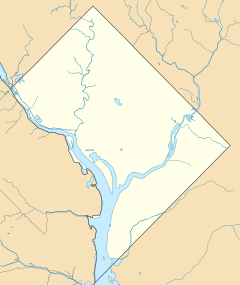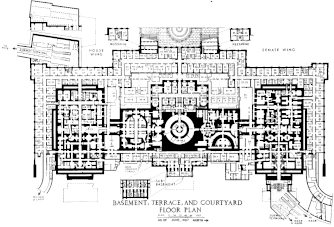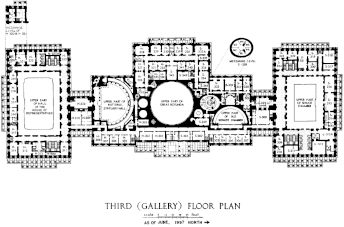
A | B | C | D | E | F | G | H | CH | I | J | K | L | M | N | O | P | Q | R | S | T | U | V | W | X | Y | Z | 0 | 1 | 2 | 3 | 4 | 5 | 6 | 7 | 8 | 9
This article contains too many pictures for its overall length. |
| United States Capitol | |
|---|---|
 The east front of the U.S. Capitol in 2013 | |
Location of the U.S. Capitol in Washington, D.C. | |
| General information | |
| Architectural style | American neoclassic |
| Town or city | Capitol Hill, Washington, D.C. |
| Country | United States |
| Coordinates | 38°53′23″N 77°00′32″W / 38.88972°N 77.00889°W |
| Construction started | September 18, 1793 |
| Completed | 1800 (first occupation) 1962 (last extension) |
| Client | Washington administration |
| Technical details | |
| Floor count | 5 |
| Floor area | 16.5 acres (67,000 m2)[1] |
| Design and construction | |
| Architect(s) | William Thornton, designer (see Architect of the Capitol) |
| Website | |
| www | |
United States Capitol | |
| Added to NRHP | December 19, 1960[2] |
The United States Capitol, often called the Capitol or the Capitol Building, is the seat of the United States Congress, the legislative branch of the federal government. It is located on Capitol Hill at the eastern end of the National Mall in Washington, D.C. Although no longer at the geographic center of the national capital, the U.S. Capitol forms the origin point for the street-numbering system of the district as well as its four quadrants.
Central sections of the present building were completed in 1800. These were partly destroyed in the 1814 Burning of Washington, then were fully restored within five years. The building was enlarged in the 1850s by extending the wings for the chambers for the bicameral legislature, the House of Representatives in the south wing and the Senate in the north wing. The massive dome was completed around 1866 just after the American Civil War. Like the principal buildings of the executive and judicial branches, the Capitol is built in a neoclassical style and has a white exterior. Both its east and west elevations are formally referred to as fronts, although only the east front was intended for the reception of visitors and dignitaries.
History
Background

Prior to establishing the nation's capital in Washington, D.C., the United States Congress and its predecessors had met at Independence Hall and Congress Hall in Philadelphia, Federal Hall in New York City, and five additional locations: York, Pennsylvania, Lancaster, Pennsylvania, the Maryland State House in Annapolis, Maryland, and Nassau Hall in Princeton, New Jersey, and Trenton, New Jersey.[3] In September 1774, the First Continental Congress brought together delegates from the colonies in Philadelphia, followed by the Second Continental Congress, which met from May 1775 to March 1781.
After adopting the Articles of Confederation in York, Pennsylvania, the Congress of the Confederation was formed and convened in Philadelphia from March 1781 until June 1783, when a mob of angry soldiers converged upon Independence Hall, demanding payment for their service during the American Revolutionary War. Congress requested that John Dickinson, the Governor of Pennsylvania, call up the militia to defend Congress from attacks by the protesters. In what became known as the Pennsylvania Mutiny of 1783, Dickinson sympathized with the protesters and refused to remove them from Philadelphia. As a result, Congress was forced to flee to Princeton, New Jersey, on June 21, 1783,[4] and met in Annapolis, Maryland, and Trenton, New Jersey, before ending up in New York City.
The U.S. Congress was established upon ratification of the U.S. Constitution and formally began on March 4, 1789. New York City remained home to Congress until July 1790,[5] when the Residence Act was passed to pave the way for a permanent capital. The decision of where to locate the capital was contentious, but Alexander Hamilton helped broker a compromise in which the federal government would take on war debt incurred during the American Revolutionary War, in exchange for support from northern states for locating the capital along the Potomac River. As part of the legislation, Philadelphia was chosen as a temporary capital for ten years (until December 1800), until the nation's capital in Washington, D.C., would be ready.[6]
Pierre (Peter) Charles L'Enfant was given the task of creating the city plan for the new capital city.[7]
L'Enfant chose Jenkin's Hill as the site for the Congress House, with a grand avenue, which is now Pennsylvania Avenue, N.W. and connects it with the White House, and a public space containing a broader grand avenue (now the National Mall) stretching westward to the Potomac River.[8][9]
Name
The term "Capitol" (from Latin Capitolium) originally denoted the Capitoline Hill in Rome and the Temple of Jupiter that stood on its summit.[10] The Roman Capitol was sometimes misconceived of as a meeting place for senators, and this led the term to be applied to legislative buildings; the first such building was the Williamsburg Capitol in Virginia.[11] Thomas Jefferson had sat here as a member of the House of Burgesses, and it was he who applied the name "Capitol" to what on L'Enfant's plan had been called the "Congress House".[8] "Capitol" has since become a general term for government buildings, especially in the United States. It is often confused with "capital"; one, however, denotes a building or complex of buildings, while the other denotes a city.[12]
Design competition
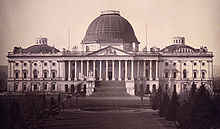
In early 1792, Thomas Jefferson proposed a design competition to solicit designs for the Capitol and the "President's House", and set a four-month deadline. The prize for the competition was $500 and a lot in the Federal City. At least ten individuals submitted designs for the Capitol; however the drawings were regarded as crude and amateurish, reflecting the level of architectural skill present in the United States at the time.[13] The most promising of the submissions was by Stephen Hallet, a trained French architect.[14] However, Hallet's designs were overly fancy, with too much French influence, and were deemed too costly.[15] A late entry by amateur architect William Thornton was submitted on January 31, 1793, to much praise for its "Grandeur, Simplicity, and Beauty" by Washington, along with praise from Jefferson. Thornton was inspired by the east front of the Louvre, as well as the Paris Pantheon for the center portion of the design.[16][17] Thornton's design was officially approved in a letter dated April 5, 1793, from Washington, and Thornton served as the first Architect of the Capitol (and later first Superintendent of the U.S. Patent and Trademark Office).[18] In an effort to console Hallet, the commissioners appointed him to review Thornton's plans, develop cost estimates, and serve as superintendent of construction. Hallet proceeded to pick apart and make drastic changes to Thornton's design, which he saw as costly to build and problematic.[19] In July 1793, Jefferson convened a five-member commission, bringing Hallet and Thornton together, along with James Hoban (winning architect of the "President's Palace") to address problems with and revise Thornton's plan. Hallet suggested changes to the floor plan, which could be fitted within the exterior design by Thornton.[20][21] The revised plan was accepted, except that Secretary Jefferson and President Washington insisted on an open recess in the center of the East front, which was part of Thornton's original plan.[22]
The original design by Thornton was later modified by the British-American architects Benjamin Henry Latrobe Sr., and then Charles Bulfinch.[23] The current cast-iron dome and the House's new southern extension and Senate new northern wing were designed by Thomas Ustick Walter and August Schoenborn, a German immigrant, in the 1850s,[24] and were completed under the supervision of Edward Clark.[25]
Construction



L'Enfant secured the lease of quarries at Wigginton Island and along Aquia Creek in Virginia for use in the foundations and outer walls of the Capitol in November 1791.[26] Surveying was under way soon after the Jefferson conference plan for the Capitol was accepted.[20] On September 18, 1793, President Washington, along with eight other Freemasons dressed in masonic regalia, laid the cornerstone, which was made by silversmith Caleb Bentley.[27][28]
Construction proceeded with Hallet working under supervision of James Hoban, who was also busy working on construction of the "President's House" (also later known as the "Executive Mansion"). Despite the wishes of Jefferson and the President, Hallet went ahead anyway and modified Thornton's design for the East Front and created a square central court that projected from the center, with flanking wings which would house the legislative bodies. Hallet was dismissed by Secretary Jefferson on November 15, 1794.[29] George Hadfield was hired on October 15, 1795, as Superintendent of Construction, but resigned three years later in May 1798, because of his dissatisfaction with Thornton's plan and quality of work done thus far.[30]
The Senate (north) wing was completed in 1800. The Senate and House shared quarters in the north wing until a temporary wooden pavilion was erected on the future site of the House wing which served for a few years for the Representatives to meet in, until the House of Representatives (south) wing was finally completed in 1811, with a covered wooden temporary walkway connecting the two wings with the Congressional chambers where the future center section with rotunda and dome would eventually be. However, the House of Representatives moved early into their House wing in 1807. Though the Senate wing building was incomplete, the Capitol held its first session of the U.S. Congress with both chambers in session on November 17, 1800. The National Legislature was moved to Washington prematurely, at the urging of President John Adams, in hopes of securing enough Southern votes in the Electoral College to be re-elected for a second term as president.[31]
Early religious use
For several decades, beginning when the federal government moved to Washington in the fall of 1800, the Capitol building was used for Sunday religious services as well as for governmental functions. The first services were conducted in the "hall" of the House in the north wing of the building. In 1801 the House moved to temporary quarters in the south wing, called the "Oven", which it vacated in 1804, returning to the north wing for three years. Then, from 1807 to 1857, they were held in the then-House Chamber (now called Statuary Hall). When held in the House chamber, the Speaker's podium was used as the preacher's pulpit. According to the U.S. Library of Congress exhibit Religion and the Founding of the American Republic:
It is no exaggeration to say that on Sundays in Washington during the administrations of Thomas Jefferson (1801–1809) and of James Madison (1809–1817) the state became the church. Within a year of his inauguration, Jefferson began attending church services in the chamber of the House of Representatives. Madison followed Jefferson's example, although unlike Jefferson, who rode on horseback to church in the Capitol, Madison came in a coach and four. Worship services in the House – a practice that continued until after the Civil War – were acceptable to Jefferson because they were nondiscriminatory and voluntary. Preachers of every Protestant denomination appeared. (Catholic priests began officiating in 1826.) As early as January 1806 a female evangelist, Dorothy Ripley, delivered a camp meeting-style exhortation in the House to Jefferson, Vice President Aaron Burr, and a "crowded audience".[32]
War of 1812
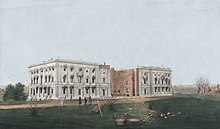
Not long after the completion of both wings, the Capitol was partially burned by the British on August 24, 1814, during the War of 1812.
George Bomford and Joseph Gardner Swift, both military engineers, were called upon to help rebuild the Capitol. Reconstruction began in 1815 and included redesigned chambers for both Senate and House wings (now sides), which were completed by 1819. During the reconstruction, Congress met in the Old Brick Capitol, a temporary structure financed by local investors. Construction continued through to 1826, with the addition of the center section with front steps and columned portico and an interior Rotunda rising above the first low dome of the Capitol. Latrobe is principally connected with the original construction and many innovative interior features; his successor Bulfinch also played a major role, such as design of the first low dome covered in copper.
House and Senate Wings
By 1850, it became clear that the Capitol could not accommodate the growing number of legislators arriving from newly admitted states. A new design competition was held, and President Millard Fillmore appointed Philadelphia architect Thomas U. Walter to carry out the expansion. Two new wings were added: a new chamber for the House of Representatives on the south side, and a new chamber for the Senate on the north.[33]
When the Capitol was expanded in the 1850s, some of the construction labor was carried out by slaves "who cut the logs, laid the stones and baked the bricks".[34] The original plan was to use workers brought in from Europe. However, there was a poor response to recruitment efforts; African Americans, some free and some enslaved, along with Scottish stonemasons, comprised most of the workforce.[35]
Capitol dome

The 1850 expansion more than doubled the length of the United States Capitol; it dwarfed the original, timber-framed, copper-sheeted, low dome of 1818, designed by Charles Bulfinch which was no longer in proportion with the increased size of the building. In 1855, the decision was made to tear it down and replace it with the "wedding-cake style" cast-iron dome that stands today. Also designed by Thomas U. Walter, the new dome would stand three times the height of the original dome and 100 feet (30 m) in diameter, yet had to be supported on the existing masonry piers.
Like Mansart's dome at Les Invalides in Paris (which he had visited in 1838), Walter's dome is double, with a large oculus in the inner dome, through which is seen The Apotheosis of Washington painted on a shell suspended from the supporting ribs, which also support the visible exterior structure and the tholos that supports the Statue of Freedom, a colossal statue that was raised to the top of the dome in 1863. The statue invokes the goddesses Minerva or Athena.[36][37] The cast iron for the dome weighs 8,909,200 pounds (4,041,100 kg).[38] The dome's cast iron frame was supplied and constructed by the iron foundry Janes, Fowler, Kirtland & Co.[39] The thirty-six Corinthian columns that surround the base of the dome were provided by the Baltimore ironworks of Poole & Hunt.[40]
Later expansion

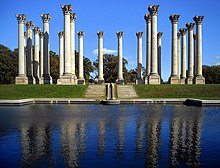

When the Capitol's new dome was finally completed, its massive visual weight, in turn, overpowered the proportions of the columns of the East Portico, built in 1828.[41]
In 1904, the East Front of the Capitol building was rebuilt, following a design of the architects Carrère and Hastings, who also designed the Russell Senate and Cannon House office buildings in 1904.[42]
In 1958, the next major expansion to the Capitol started, with a 33.5-foot (10.2 m) extension of the East Portico.[citation needed] In 1960, two years into the project, the dome underwent a restoration.[43] A marble duplicate of the sandstone East Front was built 33.5 feet (10.2 m) from the old Front. In 1962, a connecting extension repurposed what had been an outside wall as an inside wall. In the process, the original sandstone Corinthian columns were removed and replaced with marble. It was not until 1984 that landscape designer Russell Page created a suitable setting for them in a large meadow at the U.S. National Arboretum in northeast Washington as the National Capitol Columns, where they were combined with a reflecting pool into an ensemble that reminds some visitors of the ruins of Persepolis, in Persia.
Besides the columns, two hundred tons of the original stone were removed in several hundred blocks. These were first stored on site at the Capitol and then in an unused yard at the Capitol Power Plant until 1975.[44] The same year, the power plant was renovated and expanded in accordance with legislation passed in 1970, and the stones fell to the Commission on the Extension of the United States Capitol.[44] As this body was long-defunct, responsibility for the material passed to the House and Senate office building commissions.[44][45] These commissions then arranged for the National Park Service to store the debris at the back of a NPS maintenance yard in Rock Creek Park.[46][47]
With the permission of the Speaker of the House, the United States Capitol Historical Society has periodically mined the blocks for sandstone since 1975. The stone removed is used to make commemorative bookends, which are still sold to support the Capitol Historical Society.[48][49] By 1982, more than $20,000 (nearly $60,000 adjusted) had been raised through such sales.[44] Unpursued uses for the stones proposed by the Capitol Historical Society have included their sale as cornerstones in new housing developments.[44]
On December 19, 1960, the Capitol was declared a National Historic Landmark by the National Park Service.[50] The building was ranked #6 in a 2007 survey conducted for the American Institute of Architects' "America's Favorite Architecture" list.[51]
The Capitol draws heavily from other notable buildings, especially churches and landmarks in Europe, including the dome of St. Peter's Basilica in the Vatican and St. Paul's Cathedral in London.[52] On the roofs of the Senate and House Chambers are flagpoles that fly the U.S. flag when either is in session. On September 18, 1993, to commemorate the Capitol's bicentennial, the Masonic ritual cornerstone laying with George Washington was reenacted. U.S. Senator Strom Thurmond was one of the Freemason politicians who took part in the ceremony.[citation needed]
On June 20, 2000, ground was broken for the Capitol Visitor Center, which opened on December 2, 2008.[53] From 2001 through 2008, the East Front of the Capitol (site of most presidential inaugurations until Ronald Reagan began a new tradition in 1981) was the site of construction for this massive underground complex, designed to facilitate a more orderly entrance for visitors to the Capitol. Prior to the center being built, visitors to the Capitol had to line up in the basement of the Cannon House Office Building or the Russell Senate Office Building. The new underground facility provides a grand entrance hall, a visitors theater, room for exhibits, and dining and restroom facilities, in addition to space for building necessities such as a service tunnel.[citation needed]
A large-scale Capitol dome restoration project, the first extensive such work since 1959–1960, began in 2014, with completion scheduled before the 2017 presidential inauguration.[54] As of 2012, $20 million in work around the skirt of the dome had been completed, but other deterioration, including at least 1,300 cracks in the brittle iron that have led to rusting and seepage inside, needed to be addressed. Before the August 2012 recess, the Senate Appropriations Committee voted to spend $61 million to repair the exterior of the dome. The House wanted to spend less on government operations,[43] but in late 2013, it was announced that renovations would take place over two years, starting in spring 2014.[55]
In 2014, extensive scaffolding was erected, enclosing and obscuring the dome.[54][56] All exterior scaffolding was removed by mid-September 2016.[57]
With the increased use of technologies such as the Internet, a bid tendering process was approved in 2001/2002 for a contract to install the multidirectional radio communication network for Wi-Fi and mobile-phone within the Capitol Building and annexes, followed by the new Capitol Visitor Center. The winning bidder was an Israeli company called Foxcom which has since changed its name and been acquired by Corning Incorporated.[58][59]
Interior
The Capitol building is marked by its central dome above a rotunda in the central section of the structure (which also includes the older original smaller center flanked by the two original (designed 1793, occupied 1800) smaller two wings (inner north and inner south) containing the two original smaller meeting chambers for the Senate and the House of Representatives (between 1800 and late 1850s) and then flanked by two further extended (newer) wings, one also for each chamber of the larger, more populous Congress: the new north wing is the Senate chamber and the new south wing is the House of Representatives chamber. Above these newer chambers are galleries where visitors can watch the Senate and House of Representatives. It is an example of neoclassical architecture.
Tunnels and internal subways connect the Capitol building with the Congressional office buildings in the Capitol Complex. All rooms in the Capitol are designated as either S (for Senate) or H (for House), depending on whether they are in the Senate or House wing of the Capitol.
Art
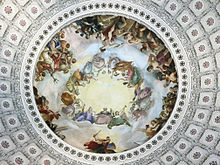

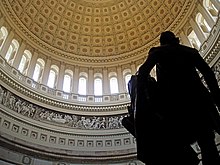


The Capitol has a long history in art of the United States, beginning in 1856 with Italian/Greek American artist Constantino Brumidi and his murals in the hallways of the first floor of the Senate side of the Capitol. The murals, known as the Brumidi Corridors,[60] reflect great moments and people in United States history. Among the original works are those depicting Benjamin Franklin, John Fitch, Robert Fulton, and events such as the Cession of Louisiana. Also decorating the walls are animals, insects and natural flora indigenous to the United States. Brumidi's design left many spaces open so future events in United States history could be added. Among those added are the Spirit of St. Louis, the Moon landing, and the Space Shuttle Challenger crew.
Brumidi also worked within the Rotunda. He is responsible for the painting of The Apotheosis of Washington beneath the top of the dome, and also the Frieze of American History.[61] The Apotheosis of Washington was completed in 11 months and painted by Brumidi while suspended nearly 180 feet (55 m) in the air. It is said to be the first attempt by the United States to deify a founding father. Washington is depicted surrounded by 13 maidens in an inner ring with many Greek and Roman gods and goddesses below him in a second ring. The frieze is located around the inside of the base of the dome and is a chronological, pictorial history of the United States from the landing of Christopher Columbus to the Wright Brothers's flight in Kitty Hawk, North Carolina. The frieze was started in 1878 and was not completed until 1953. The frieze was therefore painted by four different artists: Brumidi, Filippo Costaggini, Charles Ayer Whipple, and Allyn Cox. The final scenes depicted in the fresco had not yet occurred when Brumidi began his Frieze of the United States History.
Within the Rotunda there are eight large paintings about the development of the United States as a nation. On the east side are four paintings depicting major events in the discovery of America. On the west are four paintings depicting the founding of the United States. The east side paintings include The Baptism of Pocahontas by John Gadsby Chapman, The Embarkation of the Pilgrims by Robert Walter Weir, The Discovery of the Mississippi by William Henry Powell, and The Landing of Columbus by John Vanderlyn. The paintings on the west side are by John Trumbull: Declaration of Independence, Surrender of General Burgoyne, Surrender of Lord Cornwallis, and General George Washington Resigning His Commission. Trumbull was a contemporary of the United States' founding fathers and a participant in the American Revolutionary War; he painted a self-portrait into Surrender of Lord Cornwallis.
First Reading of the Emancipation Proclamation of President Lincoln, an 1864 painting by Francis Bicknell Carpenter, hangs over the west staircase in the Senate wing.[62]
The Capitol also houses the National Statuary Hall Collection, comprising two statues donated by each of the fifty states to honor persons notable in their histories. One of the most notable statues in the National Statuary Hall is a bronze statue of King Kamehameha donated by the state of Hawaii upon its accession to the union in 1959. The statue's extraordinary weight of 15,000 pounds (6,800 kg) raised concerns that it might come crashing through the floor, so it was moved to Emancipation Hall of the new Capitol Visitor Center. The 100th, and last statue for the collection, that of Po'pay from the state of New Mexico, was added on September 22, 2005. It was the first statue moved into the Emancipation Hall.
Crypt

On the ground floor is an area known as the Crypt. It was intended to be the burial place of George Washington, with a ringed balustrade at the center of the Rotunda above looking down to his tomb. However, under the stipulations of his last will, Washington was buried at Mount Vernon. The Crypt houses exhibits on the history of the Capitol. A compass star inlaid in the floor marks the point at which Washington, D.C. is divided into its four quadrants and is the basis for how addresses in Washington, D.C., are designated (NE, NW, SE, or SW).
Gutzon Borglum's massive Abraham Lincoln Bust is housed in the crypt. The sculptor had a fascination with large-scale art and themes of heroic nationalism, and carved the piece from a six-ton block of marble. Borglum carved the bust in 1908; it was donated to the Congress by Eugene Meyer Jr. and accepted by the Joint Committee on the Library the same year. The pedestal was specially designed by the sculptor and installed in 1911. The bust and pedestal were on display in the Rotunda until 1979 when, after a rearrangement of all the sculptures in the Rotunda, they were placed in the Crypt.[63] Borglum was a patriot and believed the "monuments we have built are not our own"; he looked to create art that was "American, drawn from American sources, memorializing American achievement", according to a 1908 interview article.[citation needed] Borglum's depiction of Lincoln was so accurate that Robert Todd Lincoln, the president's son, praised the bust as "the most extraordinarily good portrait of my father I have ever seen".[63] Supposedly, according to legend, the marble head remains unfinished (missing the left ear) to symbolize Lincoln's unfinished life.
Features
At one end of the room near the Old Supreme Court Chamber is a statue of John C. Calhoun. On the right leg of the statue, a mark from a bullet fired during the 1998 shooting incident is clearly visible. The bullet also left a mark on the cape, located on the back right side of the statue.
Twelve presidents have lain in state in the Rotunda for public viewing, most recently George H. W. Bush. The tomb meant for Washington stored the catafalque which is used to support coffins lying in state or honor in the Capitol. The catafalque now on display in the Exhibition Hall of the Capitol Visitor Center was used for President Lincoln.
The Hall of Columns is located on the House side of the Capitol, home to twenty-eight fluted columns and statues from the National Statuary Hall Collection. In the basement of the Capitol building in a utility room are two marble bathtubs, which are all that remain of the once elaborate Senate baths. These baths were a spa-like facility designed for members of Congress and their guests before many buildings in the city had modern plumbing. The facilities included several bathtubs, a barbershop, and a massage parlor.
A steep metal staircase, totaling 365 steps, leads from the basement to an outdoor walkway on top of the Capitol's dome.[64] The number of steps represents each day of the year.[65] Also in the basement, the weekly Jummah prayer is held on Fridays by Muslim staffers.[66]
Height
Contrary to a popular myth, D.C. building height laws have never referred to the height of the Capitol building, which rises to 289 feet (88 m).[67] Indeed, the Capitol is only the fourth-tallest structure in Washington.
House Chamber



The House of Representatives Chamber has 448 permanent seats. Unlike senators, representatives do not have assigned seats.[68] The chamber is large enough to accommodate members of all three branches of the federal government and invited guests for joint sessions of Congress such as the State of the Union speech and other events.
The Chamber is adorned with relief portraits of famous lawmakers and lawgivers throughout Western and Near Eastern history. The United States national motto "In God We Trust" is written over the tribune below the clock and above the United States flag. Of the twenty-three relief portraits, only Moses is sculpted from a full front view and is located across from the dais where the Speaker of the House ceremonially sits.
In order, clockwise around the chamber:
There is a quote by statesman Daniel Webster etched in the marble of the chamber, as stated: "Let us develop the resources of our land, call forth its powers, build up its institutions, promote all its great interests, and see whether we also, in our day and generation, may not perform something worthy to be remembered."[69]
Senate Chamber
The current Senate Chamber opened in 1859[70] and is adorned with white marble busts of the former Presidents of the Senate (Vice Presidents).[71]
Old Chambers
Statuary Hall (Old Hall of the House)
The National Statuary Hall is a chamber in the United States Capitol devoted to sculptures of prominent Americans. The hall, also known as the Old Hall of the House, is a large, two-story, semicircular room with a second story gallery along the curved perimeter. It is located immediately south of the Rotunda. It was the meeting place of the U.S. House of Representatives for nearly 50 years (1807–1857). After a few years of disuse, in 1864, it was repurposed as a statuary hall.
Old Senate Chamber
The Old Senate Chamber is a room in the United States Capitol that was the legislative chamber of the United States Senate from 1810 to 1859, and served as the Supreme Court chamber from 1860 until 1935.
Old Supreme Court Chamber
This room was originally the lower half of the Old Senate Chamber from 1800 to 1806. After division of the chamber in two levels, this room was used from 1806 until 1860 as the Supreme Court Chamber. In 1860, the Supreme Court began using the newly vacated Old Senate Chamber. In 1935, the Supreme Court vacated the Capitol Building and began meeting in the newly constructed United States Supreme Court Building across the street.
Floor plans
Exterior
Groundsedit
Zdroj:https://en.wikipedia.org?pojem=U.S._CapitolText je dostupný za podmienok Creative Commons Attribution/Share-Alike License 3.0 Unported; prípadne za ďalších podmienok. Podrobnejšie informácie nájdete na stránke Podmienky použitia.
Antropológia
Aplikované vedy
Bibliometria
Dejiny vedy
Encyklopédie
Filozofia vedy
Forenzné vedy
Humanitné vedy
Knižničná veda
Kryogenika
Kryptológia
Kulturológia
Literárna veda
Medzidisciplinárne oblasti
Metódy kvantitatívnej analýzy
Metavedy
Metodika
Text je dostupný za podmienok Creative
Commons Attribution/Share-Alike License 3.0 Unported; prípadne za ďalších
podmienok.
Podrobnejšie informácie nájdete na stránke Podmienky
použitia.
www.astronomia.sk | www.biologia.sk | www.botanika.sk | www.dejiny.sk | www.economy.sk | www.elektrotechnika.sk | www.estetika.sk | www.farmakologia.sk | www.filozofia.sk | Fyzika | www.futurologia.sk | www.genetika.sk | www.chemia.sk | www.lingvistika.sk | www.politologia.sk | www.psychologia.sk | www.sexuologia.sk | www.sociologia.sk | www.veda.sk I www.zoologia.sk


